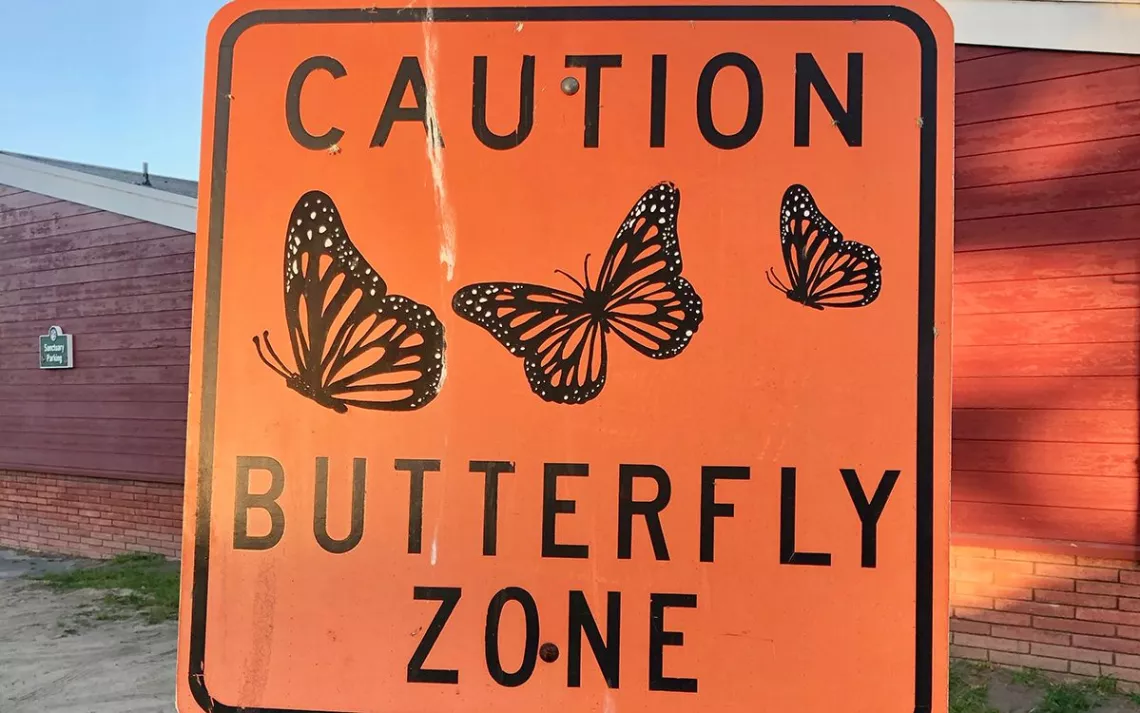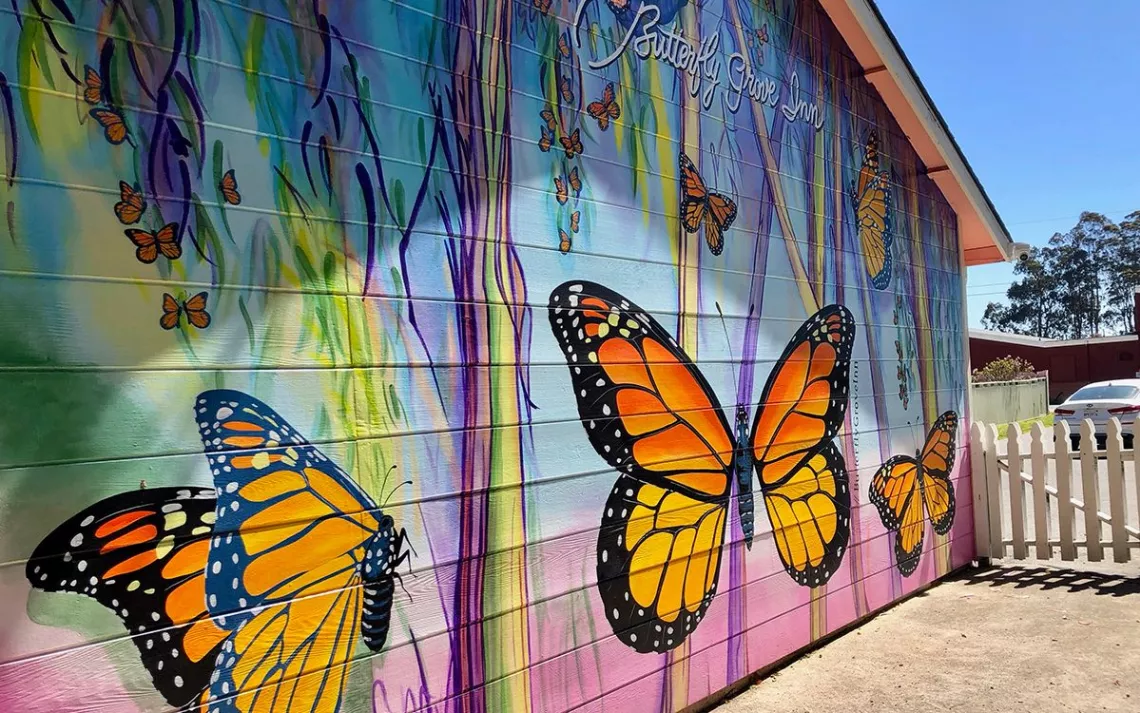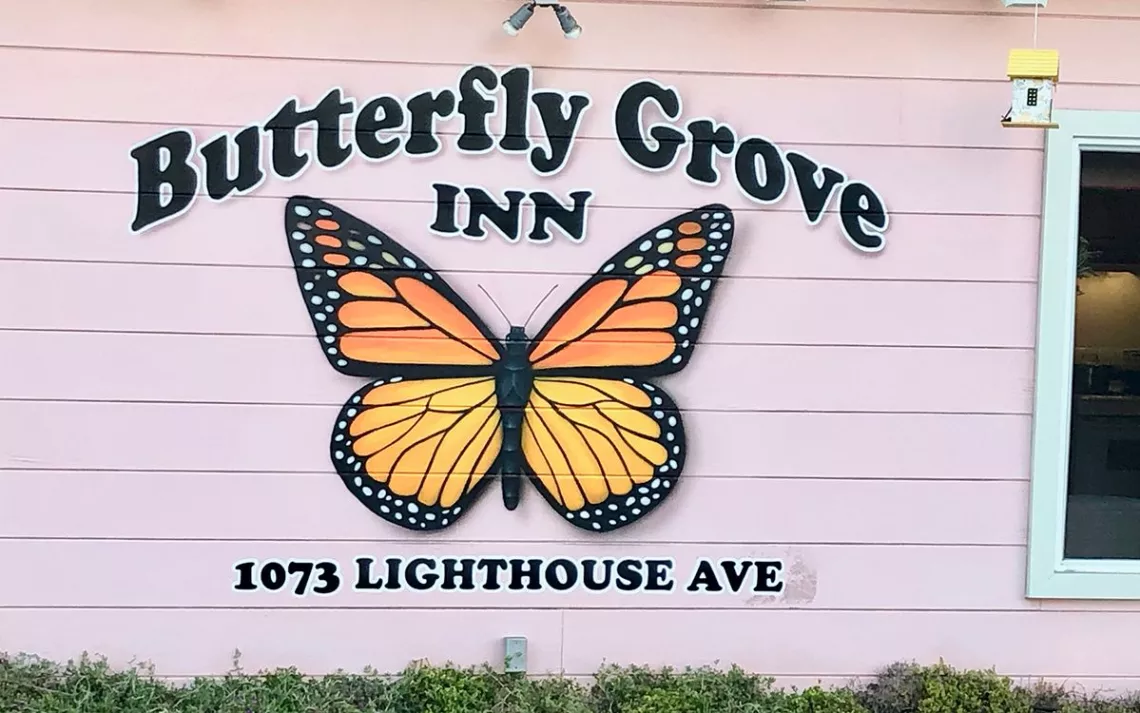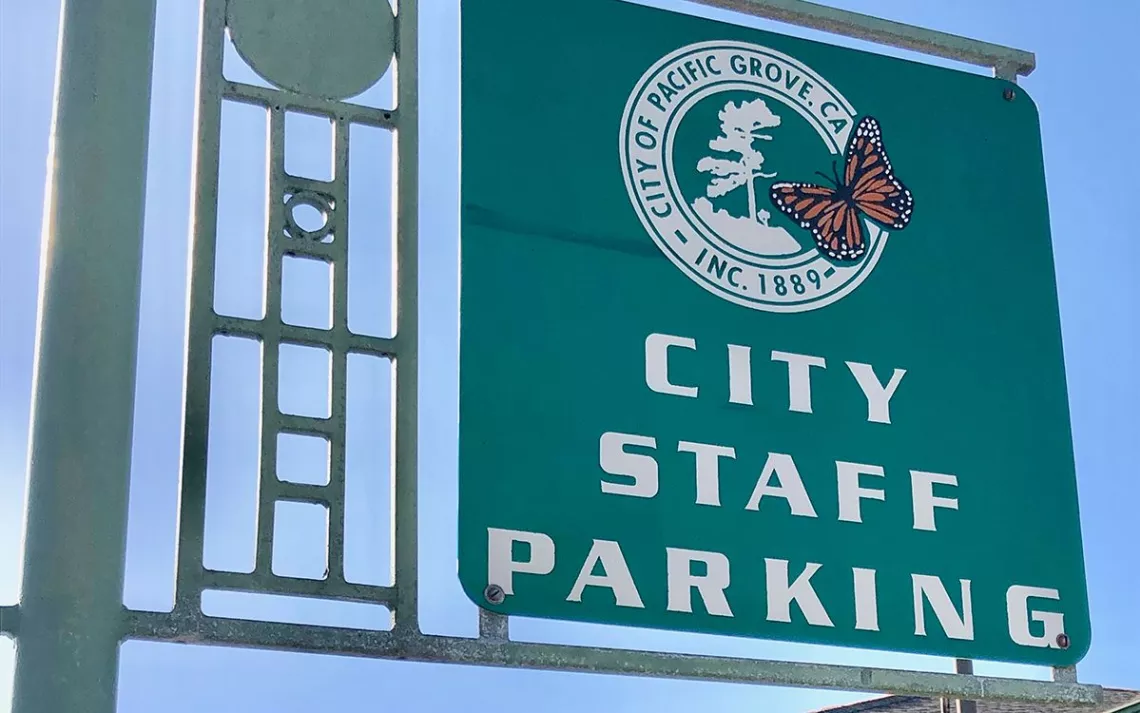The Last Days of Butterfly Town, USA
Inside humankind’s emotional attachment to monarchs—and how we might put that to work

Photos courtesy of Alec Scott
“Welcome to Pacific Grove,” the sign reads, “Butterfly Town, USA.” On the sign are two monarchs, a species that has migrated here, the tip of the Monterey Peninsula, for as long as anyone can remember. Pacific Grove has wrapped itself up in the mystique of the monarch.

Each autumn since 1939, children have paraded down its main street wearing butterfly wings, and a play put on most summers in a local park ends with two lovers transformed into butterflies, flapping into the sunset. In his own flight of fancy, former resident John Steinbeck wrote about local monarchs gorging on so much Monterey pine resin that they pass out and fall to the ground, “waving their inebriate legs in the air giving off butterfly shouts of celebration, while their places on the twigs are taken by new, thirsty millions. But Pacific Grove’s monarch ardor extends beyond plays and parades and jokey tributes. As far back as 1938, those who harmed the monarchs could be fined as much as $500 under a municipal ordinance. And in 1990, two-thirds of the town's residents passed a bond measure, putting $1.2 million in town coffers to purchase the 2.7 acres that became Pacific Grove’s butterfly sanctuary. In 1997, the first year of the now-annual count along the California coast, volunteers recorded 45,000 of them here.
A quick wander through town reveals the extent of Pacific Grove's monarch mania. A dentist's office has some frolicking on its sign, and a pub, art gallery, and knitting studio and no fewer than three hotels are named for them. The town's main grocery store stocks butterfly-shaped cookies frosted orange and black, while in the window of a shoe store a fabric monarch consorts with some strappy sandals. In a garden before one of the town's many well-appointed Victorian homes sits a roughly carved wooden butterfly perched atop a plaque that says Dream.

In other years, these tributes might feel sweet—a little daffy but innocuous. This year, though, when not a single monarch was counted in the sanctuary, they’re so many little reminders of a big broken promise.
Someone who takes that promise seriously is Bob Pacelli, known hereabouts as “the butterfly dude.” A rakish, mustachioed videographer and retired TV journalist, Pacelli shot (sometimes horrific) footage for the United Nations during the Balkan Wars of the 1990s. “I filmed lots of refugees then—they needed to be kept alive, and I feel the same thing goes here, with the monarchs. If you can keep things alive, you do,” says Pacelli, who’s spent the past 25 years shooting the monarchs of Pacific Grove and its surrounds. “They used to come into town on my birthday in early October,” he says as we wander through the butterfly-free sanctuary on a sunny spring day. “Usually there are some stragglers here this time of year, ones that haven't yet left to migrate. Not this year.”
Just over a decade ago, Pacelli led a local fight that became the subject of a 2015 documentary short, Butterfly Town USA. In the wake of what he saw as an unkind cut to a tree, he and some volunteers pushed the town to be more judicious when they lopped off limbs and to plant more trees, with the goal of keeping out butterfly-averting winds. When the town didn't move fast enough, a group led by him found some boxed trees, positioning those around the sanctuary and planting some to fill gaps. The town didn’t appreciate the intervention and removed some interloper trees. Enter documentarians.

The band of guerrilla gardeners led by Pacelli were trying to put in place ideal conditions for the monarchs that have long liked to overwinter in moist, relatively wind-free groves near the coast. There they hang (or used to hang) from their preferred trees, native pines and imported eucalyptus, in a sexually inactive state known as diapause, moving only infrequently, when the sun warmed the air, to sup on nectar from nearby plants.
“They're a little like Goldilocks,” says Martha Nitzberg, a staffer at Santa Cruz's Natural Bridges State Beach, up the coast from Pacific Grove, where just about 500 butterflies were counted this winter. “Everything has to be just right.”
Back in the Pacific Grove sanctuary, Pacelli points out trees he planted to help host the monarchs after largely winning the battle depicted in the documentary. Counts picked up for a few years, but then came this current crash, jeopardizing his legacy. Comparing this site to Natural Bridges, he notes, “There's all sorts of brush on the ground in Santa Cruz. [Monarchs] like that.”
An hour after meeting with Pacelli, I walk through the same sanctuary with Caleb Schneider, the town's environmental program manager, responsible for overseeing this grove. On scientific advice, he has had some 70 trees planted this year, but there are still areas where a strong breeze penetrates the grove. The sanctuary is surrounded on all sides by suburban yards, some of whose homeowners periodically take down or trim their trees and shrubs. “I can't stop a neighbor from cutting a tree down,” Schneider says, making it clear he'd like to. “Sometimes, there's an issue with the tree, and the homeowner's not willing to accept liability if it falls.”

Pacific Grove's sanctuary exists in the shadow of a terrible accident. In its early years, a tree branch near one entry came down and killed a grandmother who had brought her grandchild here so as to help in a school project on monarchs. (The many laws protecting humans from injury stand in stark contrast to the minimal legal protections we traditionally extend to other species. Below, we've canvassed recent litigation and existing and proposed legislation relevant to monarchs—as well as other butterflies and insects.)
For his part, Schneider is committed to making the sanctuary as hospitable to monarchs as possible, but he believes the failure of the butterflies to return this past year has nothing to do with the site's supposed inadequacies. And every scientist I interviewed agrees with him. “The loss has been general all along the coast, however the place was managed,” says Francis X. Villablanca, a biology professor at Cal Poly, San Luis Obispo.
The Central Coast's Goleta has also sometimes called itself Butterfly Town, with some justification. Its counts were once even higher than Pacific Grove's—60,000 butterflies at two main local sites. This year, Goleta volunteers also counted exactly zero butterflies hanging on the area's already drought-ravaged eucalyptus trees. And so it has gone: Counts at the mouth of Carpinteria Creek plummeted from 50,000 to 17; at Santa Barbara's Atascadero Creek they went from 20,000 to two; and at San Luis Obispo's Montaña de Oro State Park, from 50,000 to that loneliest number: one.
At traditional monarch overwintering sites, from Mendocino County in the north to Baja in the south, volunteers counted a mere 2,000 monarchs—as compared with 1.2 million counted in 1997. Most experts give the figure of 30,000 as the lowest number of monarchs needed for the migratory population to sustain itself—for the monarchs to meet up and breed during their migrations.

“The monarch migration is over in the West,” says Chip Taylor, director of Monarch Watch and a University of Kansas professor who has devoted his life to the study and protection of these butterflies. “It's done.”
The Eastern population—the one that migrates from as far north as Canada via the US midwest and Eastern Seaboard to Mexico each year— is currently struggling, albeit not to the extent of the Western population. Where the Eastern monarchs blanketed over 18 hectares in their Michoacan highlands retreats in the late 1990s, this past winter they occupied just over two hectares—representing a 90 percent decline in the past three decades and a significant fall from their nearly three hectares last year.
Estimates of how many butterflies can pack a hectare range, a little wildly, from 10 million to 50 million, meaning there are still a lot of butterflies overwintering in Mexico. Even so, Taylor isn't optimistic about this population's future: “Unless we learn the lessons from what happened in the West and take action, the end of the Eastern migration is in the cards.”
*
And just what are those lessons? There is no person who knows more about butterflies in the West than Art Shapiro, a professor at the University of California, Davis. He's been visiting the same set of sites across California's Central Valley and up into the Sierras every two weeks for nearly 50 years and has written a canonical but quirky field guide to Northern California’s butterflies. “These last three years were the first time in my life when I didn't see a single monarch caterpillar,” he says.
And it's not just the monarchs. Reached over the phone after a day in the field, Shapiro describes the declines he's witnessed in the butterfly population, the crashes in the formerly common large marble, common sootywing, and field crescent butterflies. He describes the appearance, hang-out spots, and behavior of each species with precision. Seventeen other California resident butterflies have been listed as endangered by the federal government over the years, some checkerspots and silverspots, some blues and one copper, some skippers, and the nicely named San Bruno elfin, which lives in the hills south of San Francisco. This past year, with the collapse of the monarch migration, the Feds proposed adding them and their migration to the list, with a decision on the listing anticipated by 2024.
These declines in butterfly populations, and among insects in general, are widely attributed to three main causes: climate change, the intensive use of relatively new pesticides and herbicides; and loss of habitat and host plants. Shapiro is one of many scientists who give climate change top billing. Certainly, it could help to explain why Western monarchs are faring worse than their genetically identical Eastern peers. “Where temperatures have been rising by 0.8 degrees [Fahrenheit] per decade in the West,” Monarch Watch's Taylor says, “in the Midwest, in the interior, where many of the Eastern monarchs go in the summer, that rise has been closer to 0.2 degrees per decade.”
Temperature matters to monarchs. The low ones they traditionally enjoyed at their overwintering spots sent them into a sexually inactive, near-hibernation state, and higher ones cued them to migrate and breed. Which is why several scientist interviewees spoke of a growing mismatch, especially in the West, between monarchs and their host plants—now that monarchs have been getting going on their migrations before the native species of milkweed they feed and breed upon have broken ground. (Heat waves and droughts have always adversely affected monarchs—as they do most migratory species.)
Even when monarchs can find enough milkweed to munch on at the right time, these days, each bite comes with an added kick. One of Shapiro's former graduate students, and now a frequent collaborator, Matt Forister, runs the so-called Bug Lab at the University of Nevada, Reno. The professor's team collected samples of milkweed from California's Central Valley, from plants next to farms, in plant nurseries, and in more isolated spots. Some 64 compounds used to spray agricultural fields were found in the plants, including the neonicotinoids (colloquially “neonics”) that have drawn attention for their negative impacts on bees—and which the European Union banned for outdoor use in 2018. Among these compounds, mainly found in insecticides, fungicides, and herbicides, were many that reduce monarch life expectancy and vigor. One of them, chlorantraniliprole, is commonly employed in California's nut orchards.
“There's a soup of chemicals in these plants,” Forister says, “and it's not just those growing near farms. We found some, as well, in those supplied in many nurseries to gardeners intent on helping monarchs.”
Shapiro is not surprised by his former student's findings: “I saw big declines in butterflies when these sorts of compounds, the neonics et cetera, came into widespread use, in the 1990s. That's not scientific proof, of course, but it happened at the same time.”
But based on his long experience, and the many things he sees in the field that surprise him, Shapiro cautions against easy answers. “People want things to be simple, and sometimes they aren't.” Case in point: the resident colonies of monarchs, some relatively new, reported in Los Angeles, San Francisco, the East Bay, and Silicon Valley.
David James, an associate professor at the University of Washington, has been following these developments, visiting such a colony south of San Francisco. “These monarchs have decided to reproduce in LA, San Francisco, and other places,” he says. “They are a very adaptable species. The migration will continue.”
With temperatures rising, observers, like James, are finding that the monarchs are no longer abstaining from sex in the winter months, and that they and their caterpillar offspring are finding sustenance on the so-called tropical milkweed. It, Asclepias curassavica, has been widely planted in Western gardens for years, though in recent times, monarch advocates have recommended planting species native to the West instead.
The butterflies' capacity for change has also been evident in how they've adapted to and used other introduced plant species, finding safe haven in the non-native eucalyptus trees, enjoying the nectar provided by the plentiful English ivy at the longtime overwintering spot in Santa Cruz's Natural Bridges. (Some new research indicates that all things being equal, they still prefer the native plants to others. Even so, the monarchs complicate the emerging orthodoxy on native plants.)
In Pacific Grove, Pacelli, the butterfly dude, isn't giving up the fight—he’s still hand-raising eucalyptus and other trees to plant in Pacific Grove yards and nearby places where monarchs still come, or might come, to make them better draws. “I can't not do anything,” he says simply. I also spoke with a Pacific Grove realtor who's planning to give a portion of her house sales to support monarch-friendly gardens. “I'm speaking to the library about planting plants they like in a bed in front of it.” The manager of a motel near the sanctuary, boasting a huge trippy mural of monarchs, is also hopeful. A spokesman for the Pacific Grove Chamber of Commerce who marched in the butterfly parade when he was little has said there are no plans, as yet, to try to rebrand his hometown.
All in all, there's a sad disconnect on display here between the nice American capacity for can-do optimism and the emerging facts and science.
I sit in on a Zoom gathering of government officials charged with the monarchs' well-being—from California's Coastal Commission, its Fish and Wildlife Department, and various coastal towns that formerly hosted overwintering colonies—as well as a monarch expert from the Xerces Society, an NGO charged with protecting insect life. (The name comes from the Xerces blue, a now-extinct butterfly that once lived in a tiny enclave in San Francisco.) Pacific Grove's Caleb Schneider is on the video call, reporting on things in the town, and so is Cal Poly's Villablanca, who's collaborating on rapidly conducted and written up research speaking to the changing realities in the West. “We're hoping we can understand much of this before it's too late.”
So many humans are rooting for the monarchs, and putting their time into the fight to defend them. But James is one of the few scientists who have been watching their progress for years to be hopeful. Others are starting to use the E-word—extinction—with respect to the Western monarchs. When I walk through the butterfly-less sanctuary in Pacific Grove, I'm visited by this terrible vision: If they never come back, perhaps all the butterfly mementos in Pacific Grove should be assembled here, an installation reminding us of what we're doing to the planet.
I pose the same question to many who've devoted large swaths of their lives to this small, fluttering creature and its less prominent kin: Why? The butterflies are, at best, fitful pollinators. With all the creatures apparently going down in the so-called Sixth Extinction, why focus on the monarch?
Monarch Watch’s Taylor says their often incredible journeys have served to dramatize the universal struggle for survival. “When I visited their highland retreat in Mexico, there were so many with broken wings, other damage, who’d somehow made it there, in an effort to reproduce. Maybe only the salmon with their upstream trips also demonstrate that push for life.”
He says they also channel our capacity for magical thinking. He frequently gets calls from people who say that, after a death, a monarch’s landed on the shoulder of one of the people grieving, that they feel it is the soul of the departed coming in for a last visit. In Mexico, of course, monarchs have long returned on or around the Day of the Dead, and their association with souls of the dead is woven into the celebration.
Few monarchs have been sighted in Washington State of late, which is where James has worked with a local prison, getting inmates to raise the caterpillars and release them. “It's more popular than raising kittens and puppies,” he says. “There's a reason the butterfly is one of the most popular tattoos.” (Raising monarchs, we should note, is controversial, because they can be affected by an ailment, Ophryocystis Elektroscirilla, known as OE. James and Taylor both say that carefully raising small numbers of monarchs, for educational and other purposes, is not likely to jeopardize the wild population, as many naturally raised butterflies also have this relatively chronic ailment. A cleansing of the eggs can minimize OE in homegrown butterflies. California has recently required any who would handle monarchs to obtain permits.)
For me, as for Pacelli, the monarchs carry a birthday association. I was born in late May in southern Ontario, and they arrived each year, around that time. My first print-media memory is of a 1970s National Geographic featuring massive amounts of them on the cover, and within, a feature about Canadian scientists' reported discovery of the monarch's Mexican overwintering spot. (Says Pacelli drily: “The Mexicans always knew they were there; just the international scientific community didn't.”)
But it's not just magical thinking they elicit. I remember being rapt at a pair of them that had come across the wide St. Lawrence River to frolic in the grass near a cottage my family was renting. The amateur lepidopterist Vladimir Nabokov wrote in his memoir, Speak Memory: “The highest enjoyment of timelessness … is when I stand among rare butterflies and their food plants. This is ecstasy, and behind the ecstasy is something else which is hard to explain. It is like a momentary vacuum into which rushes all that I love. A sense of oneness with sun and stone. A thrill of gratitude to whom it may concern.”
For me and so many others, the world would be vastly diminished with their passing, but to what use can we put this sense of enchantment?
Having watched so many of his beloved butterfly species in a state of decline and imminent fall, Shapiro is plain spoken. “When people ask me what they can do for the monarch, I say you can vote for politicians with a sensible approach to the climate. Without that, you can plant all the milkweed you want, but if there are no butterflies to eat it, then ...” He recently said if he were starting his career now, he would not study butterflies. “There won’t be enough work to sustain a career.”
The name most are using for this age of human dominance is the Anthropocene, but a term deployed by environmental writer E.O. Wilson, among others, seems somehow more apt: the Eremocine, a neologism for the Age of Loneliness. A world without butterflies would certainly be a more lonely one. “Our love for them, and for nature in general, it's deep in us,” says Cornell's Anurag Agrawal, another former student of Shapiro's, who has a butterfly on his cheek in his LinkedIn profile shot. “Their losses feel like ours—and they are ours, since they speak to the health of the continent, of the world.”
Monarch-Forward Legislation and Litigation
Last December, the US Fish and Wildlife Service made the monarch a “candidate” for listing under the Endangered Species Act and slated an annual review of its status. Informed observers expect a decision by 2024.
A consortium of farming associations led by the Almond Alliance of California and the California Association of Pest Control Advisers recently challenged the state's ability to designate four species of bumblebee under the state Endangered Species Act. In a decision released in November, the California Superior Court concluded that the state exceeded its statutory authority. Judge James Arguelles reasoned, “The word 'invertebrates' as it appears in … [the Act] clearly denotes invertebrates connected to a marine habitat, not insects such as bumblebees.” This would also limit the state's ability to take action under the ESA with respect to butterflies. The state and intervenor, the Xerces Society for Invertebrate Conservation, have appealed the decision. The growers’ association leading the litigation did not respond to a request for comment on this case or on its members’ use of pesticides.
Earlier this year, a group of senators led by Oregon's Jeff Merkley introduced the Monarch and Pollinator Highway Act, which would earmark $30 million for grants to agencies working at making roadsides better places for butterflies and other pollinators. The aim would be to encourage the planting of milkweed and other pollinator-friendly plants and to reduce mowing of highway verges. Another just-introduced bill, the Monarch Action Recovery and Conservation of Habitat Act, would give $60 million over five years to a Western Monarch Butterfly Rescue Fund, which would also dole out grants to those with plans to assist the now scarce butterflies.
 The Magazine of The Sierra Club
The Magazine of The Sierra Club



